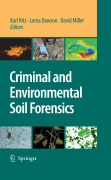
Soils have important roles to play in criminal and environmental forensic science. Since the initial concept of using soil in forensic investigations was mooted by Conan Doyle in his Sherlock Holmes stories prior to real-world applications, this branch of forensic science has become increasingly sophisticated and broad. New techniques in chemical, physical, biological, ecological and spatial analysis, coupled with informatics, are being applied to reducing areas of search by investigators, site identification, site comparison and measurement for the eventual use as evidence in court. Soils can provide intelligence, in assisting the determination of the provenance of samples from artifacts, victims or suspects, enabling their linkage to locations or other evidence. Theyalso modulate change in surface or buried cadavers and hence affect the ability to estimate post-mortem or post-burial intervals, and locate clandestine graves. Unique Volume - no precendent State-of-the-art prespective from leading practitioners from around the World Use of soil forensics from intelligence gathering to evidence in court, with casework examples Multi-disciplinary coverage e.g. expert witness to molecular ecology of cadaver decay in soils Global perspective-international coverage of contributing authors INDICE: From the contents Acknowledgements. Contributors. Introduction. Foreword. Concepts. Evidence. Geoforensics. Taphonomy. Technology. Postscript. Index.
- ISBN: 978-1-4020-9203-9
- Editorial: Springer
- Encuadernacion: Cartoné
- Páginas: 400
- Fecha Publicación: 01/01/2009
- Nº Volúmenes: 1
- Idioma: Inglés
